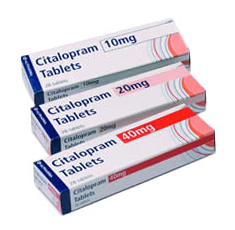Celexa (Citalopram)
Celexa (citalopram) is a selective serotonin reuptake inhibitor (SSRI) antidepressant. It increases serotonin activity in the brain, which helps regulate mood. Celexa is good for treating depression and anxiety. Side effects are less likely to happen compared to other antidepressants; however, it is not the best choice for people with heart or liver problems.

Why is this drug prescribed?
Celexa is used to treat depression. Citalopram is in a class of antidepressants called selective serotonin reuptake inhibitors (SSRIs). It is thought to work by increasing the amount of serotonin, a natural substance in the brain that helps maintain mental balance. Citalopram is also sometimes used to treat eating disorders, alcoholism, panic disorder (condition that causes sudden attacks of extreme fear with no apparent cause), premenstrual dysphoric disorder (a group of physical and emotional symptoms that occur before the menstrual period each month), and social phobia (excessive anxiety about interacting with others). Talk to your doctor about the possible risks of using this medication for your condition.
Buy Celexa
Reasons to buy Celexa:
- Effectively relieves depression symptoms.
- This medicine is not as drowsy as other antidepressants.
- Available as a generic, which is cheaper.
- Best choice among antidepressants
- Side effects are less likely to happen compared to other antidepressants
How should this medicine be used?
Celexa comes as a tablet and a solution (liquid) to take by mouth. It is usually taken once a day, in the morning or in the evening, with or without food. Take citalopram at around the same time every day. Follow the directions on your prescription label carefully, and ask your doctor or pharmacist to explain any part you do not understand. Take citalopram exactly as directed. Do not take more or less of it or take it more often than prescribed by your doctor.
Your doctor may start you on a low dose of citalopram and gradually increase your dose, not more often than once a week.
It may take 1 to 4 weeks before you notice the full benefit of citalopram. Continue to take citalopram even if you feel well. If you suddenly stop taking citalopram, you may experience withdrawal symptoms such as mood changes, irritability, agitation, dizziness, numbness, tingling or electric shock-like sensations in the hands or feet, anxiety, confusion, headache, tiredness, nausea, sweating, shaking, and difficulty falling asleep or staying asleep. Do not stop taking citalopram without talking to your doctor. Your doctor will probably decrease your dose gradually.
Warnings and Precautions
There are several Celexa warnings and precautions to be aware of before taking this drug. For example, Celexa may not be safe to take during pregnancy. Also, people who take both Celexa and nonsteroidal anti-inflammatory drugs (NSAIDs) are at a higher risk for gastrointestinal bleeding. Before taking Celexa, be sure to tell your doctor if you have bipolar disorder, liver disease, or a history of suicide attempts.
The dose regimen

Depression:
Depression in patients whose diagnosis corresponds most closely to the DSM-III and DSM-III-R category of major depressive disorder
Initial dose: 20 mg/Day.
If needed, may increase to 40 mg/day after at least 1 week.
Doses above 40 mg/day are not recommended, because of risk for QT prolongation without additional benefit for treating depression
Dosing Modifications
Hepatic impairment decreases clearance and therefore increases risk of QT prolongation; do not exceed 20 mg/day
MAO inhibitors
- Not for administration within 14 days of administering a MAO inhibitor
Linezolid or Methylene Blue Therapy
- Not for administration to patients that are receiving linezolid or IV methylene blue; consider other forms of therapy; if therapy required and benefits outweigh risks discontinue citalopram therapy, administer linezolid or methylene blue and monitor for serotonin syndrome for 2 weeks or 24 hr after last dose of linezolid or methylene blue
Renal impairment
- Mild to moderate renal impairment: No dosage adjustment required
- Severe renal impairment (CrCl <20 mL/min): Not studied; use with caution
Alcoholism:
20-40 mg/Day
Binge-eating Disorder:
20-60/Day
Generalized Anxiety Disorder:
Initial: 10 mg/Day; may titrate to 40 mg/day
Panic Disorder:
20 mg/Day initially; after 1 week, may increase to 40 mg/day if warranted
Not to exceed 40 mg/day because of increased risk for QT prolongation
Hot Flashes
Initial: 10 mg/Day; may increase to 20 mg/day after 1 week
Obsessive-Compulsive Disorder
Initial: 20 mg/Day; may titrate to 40-60 mg/day; improvement may be seen 4-6 weeks after initiating therapy
Premenstrual Dysphoric Disorder
5 mg on the estimated day of ovulation; increase dose by 5 mg each day thereafter to maximum 30 mg; continue thereafter until menstruation begins; decrease dose to 20 mg on the first day of menstruation; the next day, decrease to 10 mg; stop the treatment from day 3 until ovulation begins.
Antidepressants
Sleeping Pills
Anxiety
Depression Basics
Bipolar Disorder
Men Depression
Women Depression
- Depression in Women as a common problem
- Social & Cultural causes of Women Depression
- Female Depression & Suicide
- Why Women Depression is More Common Than Men
- Top 10 Causes of Female Depression
- How Friends & Family Can Help a Depressed Woman
- List of Sources Depressed Women Get Help
- Female Depression Symptoms
- More Female Depression Symptoms
